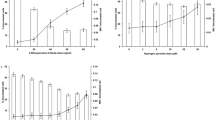Abstract
A tumour initiating dose of ethyl carbamate was administered to mice by subcutaneous injection together with a dose of one of the homologous esters or an ethyl N-alkyl derivative. The homologues used were the methyl, n-propyl and n-butyl esters, and the derivatives were the N-methyl, N-ethyl and N-n-propyl ethyl esters. The mice were then given promoting treatment with croton oil for 28 weeks.
Neither the homologous esters nor the N-substituted derivatives of ethyl carbamate had any influence on the yield of tumours in the skin, lung, or liver. However, increasing the dose of ethyl carbamate increased the yields of tumours.
This is a preview of subscription content, access via your institution
Access options
Subscribe to this journal
Receive 24 print issues and online access
$259.00 per year
only $10.79 per issue
Buy this article
- Purchase on Springer Link
- Instant access to full article PDF
Prices may be subject to local taxes which are calculated during checkout
Similar content being viewed by others
Rights and permissions
About this article
Cite this article
Pound, A. Tumour Formation in Mice by Urethane Administered With Related Carbamates. Br J Cancer 26, 216–225 (1972). https://doi.org/10.1038/bjc.1972.29
Issue Date:
DOI: https://doi.org/10.1038/bjc.1972.29
This article is cited by
-
The use of yeast inoculation in fermentation for port production; effect on total potential ethyl carbamate
Biotechnology Letters (1996)



